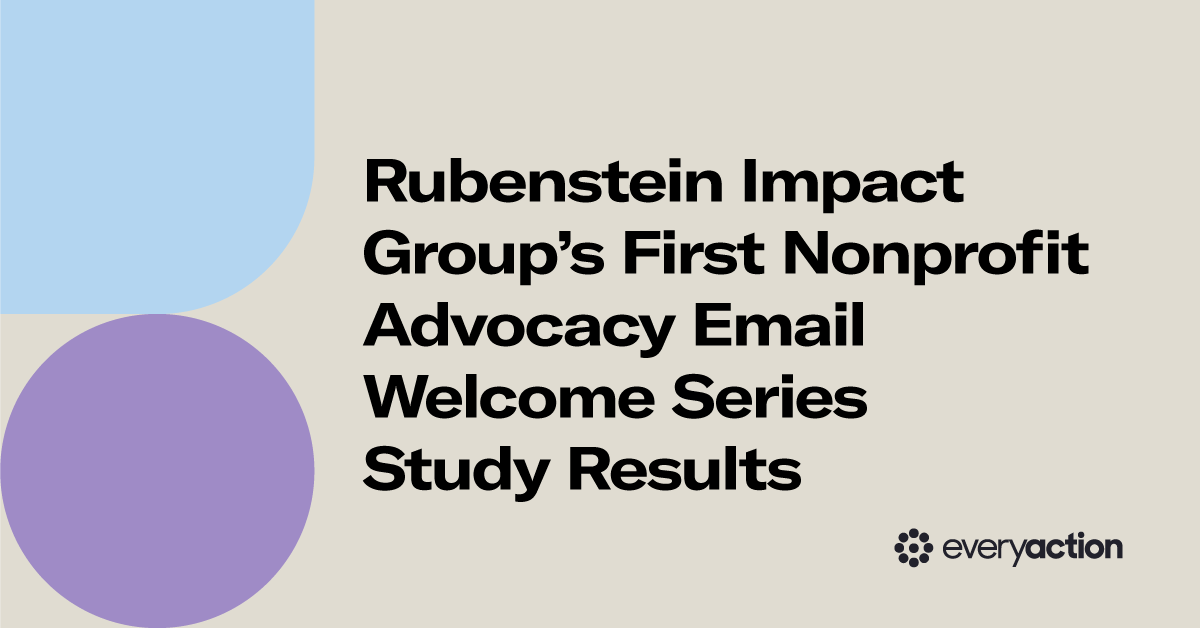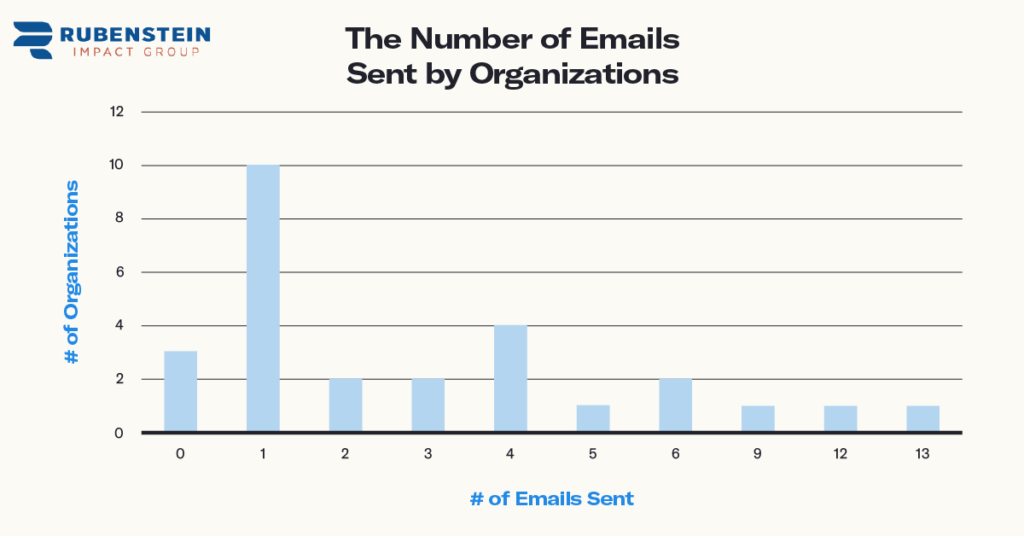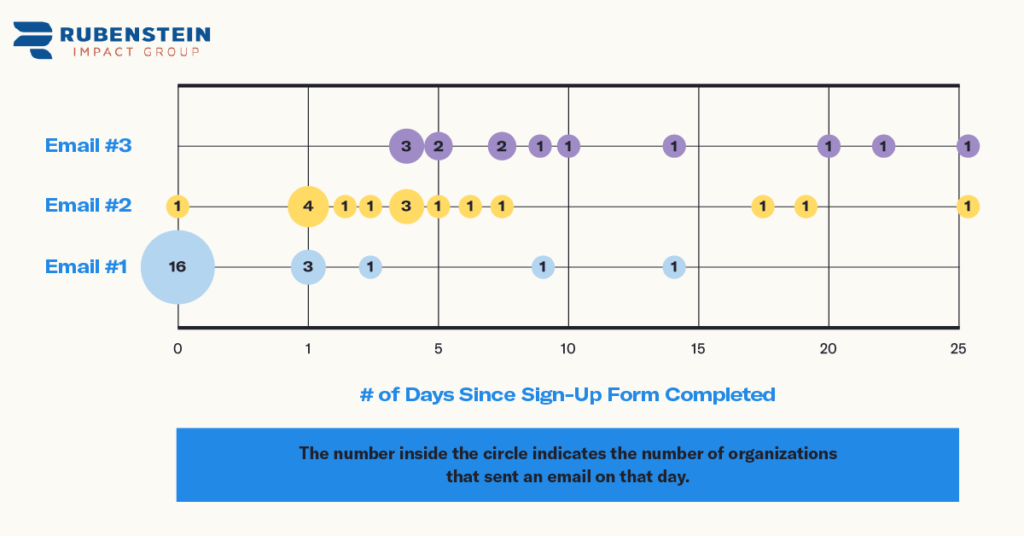Rubenstein Impact Group’s First Nonprofit Advocacy Email Welcome Series Study Results

If you’re a nonprofit digital strategist, fundraiser or other practitioner, you know there are massive (even magical!) levels of power just waiting to be unleashed within the first emails a new supporter receives after subscribing to your organization’s email list. After all, those first short messages need to capture the person’s attention, tap into their imagination, and begin transforming them from a line of contact data into a true activist, donor, or volunteer—maybe even all three.
Because recruiting new supporters is such an important project, organizations invest enormous effort into creating and branding a campaign, testing recruitment ads, and optimizing landing pages in order to get the best results. Standard questions for measuring a campaign’s success usually include, “What was the conversion rate? What was our cost per acquisition? How many impressions did we get?”
However, these next questions are equally important: “Then what happened? What did we do to keep engaging these new volunteers for the long-run?” These questions are what led Rubenstein Impact Group to launch our first study reviewing the email welcome series of nearly 30 nonprofit organizations. Keep reading to discover how we designed our study; what we found; and our recommendations for ensuring your organization has a highly effective series.
What we did
Our methodology focused on a select group of nonprofit organizations’ email welcome series. We joined the email list for 27 national organizations using a new Gmail address created specifically for this project.
Our goal was to sign up specifically to receive advocacy information or become an advocacy volunteer, so we visited each organization’s website, navigated to the advocacy section of the site, and completed a form that appeared to be advocacy-specific. (Even if your nonprofit organization doesn’t engage in advocacy, don’t stop reading—our findings can help you too!)
For each organization, we tracked all of the emails received during the first 30 days after completing the sign-up form. This included emails received in the Primary, Social, Promotions and Spam folders/tabs in Gmail.
What we found
As you’d expect, there is no one right way to execute an email welcome series and the results of our study illustrate that. Some organizations emailed very aggressively and quickly dropped us into intensive fundraising campaigns, while others were more deliberate in taking the time to build a relationship with their newest advocacy subscribers.
Despite these differences, we were able to identify some clear findings and recommendations that can serve as a useful guide for organizations considering how best to launch or refresh their own series. Our findings are split into three areas: how many emails we received; how often we received those emails; and the content of those emails.
1. How many emails are organizations sending?
When we signed up for advocacy emails, we tracked how many messages we received from the organizations—and the results ranged widely. Some sent us as many as 13 messages, and we were surprised to see that four out of the 27 organizations in our study sent us zero messages in the first thirty days after acquiring our email address. Overall, we received an average of 3.1 emails per organization during our first thirty days as a subscriber.
It’s also important to acknowledge that the results for this finding might have been different had we signed up through a different entry point, particularly one that reflects a stronger immediate affinity for the organization’s work like a donation form or event sign-up.
Regardless of the entry point, there is ample data external to this study that documents the positive impact a welcome series can have on driving a very quick second engagement from a new volunteer, whether the follow-up ask relates to donations, legislative action, or other activities. A study by MailMunch found that welcome emails are 320 percent more efficient than other promotional emails.
Recommendation #1: Three(ish) is the magic number
People who sign up for your list want to hear from you. Our study’s findings are consistent with our recommendation that organizations implement a three- to four-part email welcome series for new subscribers during the first 30 days. We believe that provides volunteers with the ability to learn about the organization and engage in a variety of ways without flooding their inboxes.

2. How often are organizations sending these emails?
While the first question organizations often ask is how many emails to send, how often to send them is usually the immediate follow-up question.
We observed much less variance in the pacing of the emails than we did in the number of emails sent. Of the 27 organizations in our study, we observed three clear trends in email frequency:
- Nearly 60 percent of the organizations sent an autoresponder email that we received immediately after completing their form. Of those that sent emails, only two organizations sent their first message more than five days after the initial sign-up.
- The timing for the second email sent was also fairly consistent: of those who sent more than one email, 80 percent of the organizations sent us their second message within five days of their first one.
- Just under half of the organizations in the study sent a third message at all. However, of that group, a small number of organizations—less than 20 percent—paced their email stream aggressively by sending their third message within five days of the initial form completion.
Recommendation #2: Let your data guide you
We’re regularly asked how to know if you’re sending too many emails too quickly, and our answer is always the same: monitor your performance data and follow its lead. Clickthrough, unsubscribe, and conversion rates will empower you to make informed decisions about the intensity of your welcome series. A/B testing that varies your pacing is also a great way to optimize that cadence.

3. What kinds of content are organizations including in their emails?
Email ask content
To evaluate the email content, we broke down the messages we received into 10 types of asks and tracked how many fell into each category:
| Ask in the Email | % of emails received with that ask |
| Advocacy action | 20% |
| Donate | 17% |
| None | 16% |
| Read more information | 15% |
| Event sign-up | 7% |
| Interest survey | 6% |
| Social media share/follow | 6% |
| Miscellaneous | 6% |
| Share your story | 5% |
| Options to get involved | 3% |
We found that an advocacy-related ask (i.e., send a message to your lawmaker,) was the most common, which was to be expected since this was the most relevant type of ask for the form we completed. This was followed closely by a donation solicitation, and then by links to more information about the organization and its work.
However, only 48 percent of the 87 total emails over the course of this study included at least one mention of advocacy. This was a bit concerning as in the sign-up process we were very deliberate to subscribe via a form housed on an advocacy page. In order to be highly relevant, welcome series content should reflect the reason a subscriber filled out your form and joined your list.
While many of the emails we received included a clear call-to-action, just over 16 percent of them included no ask at all. With Apple’s release of iOS 15 late last year, email open rates are becoming a more limited measure of email performance, which means having a clickable ask in your message is more important than ever.
Other email content
To be successful, any advocacy welcome series should make advocacy the main focus. However, a well written email can promote other key mission programs like donation opportunities or events while also making clear how they’re related to advocacy. For example, an email promoting a fundraising walk to an advocacy audience should tell subscribers how that program helps fund the organization’s advocacy work, or explain that the organization will be collecting petition signatures at the finish line.
Recommendation #3: Diversify and refresh your content, and always include an ask
The key to maximizing engagement with your ask is to diversify your welcome stream content, keep it relevant with connections to the reason your audience engaged with you—in this case, advocacy—and include a clickable ask. Offering a range of relevant content provides your volunteers with multiple ways to grow their connection with your organization.
Tipping our hat
One thing that became clear to us as we were conducting this study is that there are some very impressive welcome series out there—Save the Children Action Network and the Leukemia Lymphoma Society have two of the best we saw! If you’re a digital content strategist or wish to one day become one, we’d recommend signing up for their lists and checking out the goodness as it flows into your inbox.
In closing
While our study was focused on advocacy welcome series, all of our findings are highly relevant and transferable for non-advocacy organizations. Ultimately, your audiences want to hear from you and engage—and they want to do it before they’ve forgotten that they signed up for your list.
During this study, we also documented the online sign-up experience for each organization, and will have more to share about these findings and other welcome series best practices—stay tuned for more!
If you would like a complimentary review of your organization’s welcome series and receive a customized report to understand how it compares to the results of this study, or if you’d like help refreshing your welcome series and improving your overall digital communications program, we’d love to partner with you—send us a note at brian@rubensteinimpact.com.
About Rubenstein Impact Group
Rubenstein Impact Group helps nonprofit organizations and companies drive greater engagement with their audiences—volunteers, members, employees, customers and partners—to deepen relationships, run successful campaigns and strengthen their brand.


